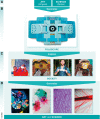Art and science: Intersections of art and science through time and paths forward
- PMID: 30591523
- PMCID: PMC6362349
- DOI: 10.15252/embr.201847061
Art and science: Intersections of art and science through time and paths forward
Abstract
Science and art have a long‐standing relationship as both are based on observation and interpretation. In this technology‐driven age, new interactions could lead to novel ways of looking at and interpreting complex systems.
Figures




References
-
- Kemp M (2005) From science in art to the art of science. Nature 434: 308–309 - PubMed
-
- Minder R (2013) The wonders of the Islamic worlds of art and science, illuminated. The New York Times.
-
- Snow C (1959) The Two Cultures and the Scientific Revolution. Cambridge: Cambridge University Press;
-
- Schaff PB, Isken S, Tager RM (2011) From contemporary art to core clinical skills: observation, interpretation, and meaning‐making in a complex environment. Acad Med 86: 1272–1276 - PubMed
-
- Williams G (2017) Are artists the new interpreters of scientific innovation? New York Times
Publication types
LinkOut - more resources
Full Text Sources

